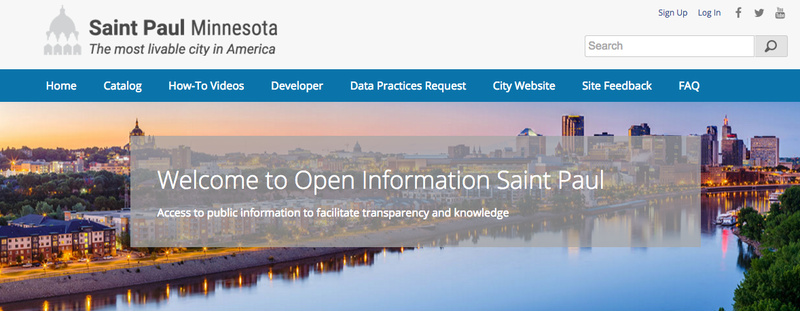OpenGov Voices: ‘Open Information St. Paul’ makes data dynamic, relevant and user-friendly

In St. Paul, we have stopped talking about open data.
Data by itself is only useful to a small number of people – usually people who are highly literate in technology and numbers. We want to spark a culture of innovation across our city, and data alone won’t be enough to get us there.
To achieve our vision, we need to give people more than access to spreadsheets. We seek to provide the public with information so they can make informed decisions about their lives in St. Paul, and so they can help us identify challenges and innovative solutions to city problems. We’re not building our portal for a niche group. We’re aiming for the masses.
So instead of talking about open data, we’re talking about open information. We believe an informed, engaged public can participate more fully in their community and help us innovate in our quest to make St. Paul the most livable city regardless of age, gender, race, income or any other marker of identity. To that end, we are thinking about the kinds of data that can help people in their everyday lives. Maybe you own a construction company that you want to grow, so you’re interested in learning what types of permits are being pulled most often. Maybe you’re a community activist wondering how election turnout compares in precincts across the city. Maybe you’re looking to buy a house and you would like to know crime information for the neighborhoods you’re considering. We at the city of St. Paul want to help people find easy answers to those questions and more.
We recently launched our open data portal, Open Information St. Paul, with the aim of providing an open data site that is dynamic, relevant and user-friendly. St. Paul was not among the first cities to publish our data online via a portal, but with the launch of this site we became part of the “second wave of open data sites, where data is not just made ‘available’ as massive text files, but also visualized in interesting and compelling ways.”
When we identify a dataset destined for the open information portal, we determine how easily updates can be automated as well as how we can create meaningful visualizations off that dataset. By taking the time up front to ensure the data will always be timely and accurate — and then taking the extra step to create easily understandable visualizations — we are focused on delivering an excellent user experience. For example, a user interested in learning about vacant buildings in St. Paul can view charts illustrating numbers by building type, vacancy date, a map of building locations and more. With a simple click, these charts can be filtered to see details for particular subcategories, such as all single-family residential vacancies, and individual dots on the map can be clicked to pinpoint location and other details.
St. Paul insights: Business intelligence for city government
The Open Information portal is one part of a larger business intelligence program we are calling “Saint Paul Insights.” The goal is simple: provide the information staff need to make decisions, when and where they need to make them.
What do we mean by “business intelligence”? Our definition is this: the use of data analysis tools and applications to help business users turn data into information.
The St. Paul Insights program has three main tenets:
1. Educate: enable city departments to become self-sufficient business intelligence users 2. Automate: mitigate risk of reporting errors by automating dataset uploads whenever possible 3. Communicate: keep our internal business partners up-to-date and identify opportunities for engaging the public through their suggestions and feedback.
Our business intelligence infrastructure will have three components: the business intelligence tools, governance and methodology for cataloging St. Paul’s data assets; the public-facing open information platform; and the policy and data governance structures to hold it all together. We engaged strategic partners to help develop each of these areas. Heartland Business Systems provides the business intelligence expertise St. Paul needs to truly manage our data as an asset the same way we manage our physical assets such as street lights or public buildings. Learning to manage data as an asset is a big and exciting shift in organizational culture. Socrata provides the open information platform, advises us on best practices and connects us with our peers in other cities. The Sunlight Foundation, via St. Paul’s recent designation as a Bloomberg Philanthropy “What Works City”, guided us in developing the resolution presented by Mayor Coleman to City Council, and also consulted on our data governance structure.
By uniting these areas of work under the St. Paul Insights strategy, we seek to help city staff see that open information is about more than transparency and accountability — it’s an integral component to our ability to make data-based decisions.
The beginning of a data-driven conversation
While it would be easy to see the launch of Open Information St. Paul as the capstone achievement in a year’s work on this project, we believe it is a beginning rather than an end. Coleman’s recent announcement of the Open Information site in his 2016 State of the City address is the start of what we hope becomes a long, iterative conversation between the community and city government about what data matters, why it matters and how we can learn from it to deliver better services for our residents.
View the video of St. Paul’s open data resolution, which passed unanimously, here.
Interested in writing a guest blog for Sunlight? Email us at guestblog@sunlightfoundation.com

